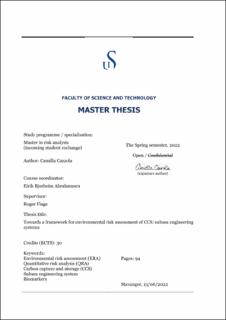Towards a framework for environmental risk assessment of CCS: subsea engineering systems
Master thesis
Permanent lenke
https://hdl.handle.net/11250/3005146Utgivelsesdato
2022Metadata
Vis full innførselSamlinger
- Studentoppgaver (TN-ISØP) [1428]
Sammendrag
Nowadays, we are observing a continuous rise in trends of greenhouse gasses’ concentration in the atmosphere, especially of carbon dioxide, and this is, in great part, attributable to human activities. The first detrimental effects on climate have already been observed and ever more long-term changes in weather patterns should be expected if no concrete action to contrast these trends is put in practice. The scientific community is thus suggesting innovative and practical solutions for both mitigating climate change and adapting to its impacts: carbon capture and storage (CCS) is one such option. CCS involves capturing carbon dioxide (CO2) from power plants, industrial activities and any other sources of CO2 and storing it in a geological formation. The appeal of this technique resides in the fact that CCS is able to combine the use of fossil fuels, on which our society still relies a lot, with the environmental exigency to cut carbon dioxide’s emissions. However, despite the interesting mitigation option offered by CCS, there is the impelling need, as for any other human activity, to assess and manage risk; this work is intended to do so.
The focus is, more precisely, on marine environmental risk posed by CO2 leakages, as how this risk should be addressed still represents a largely debated topic. Specific risks can be associated to each of the stages of a CCS system (capture, transport and storage). The focus of this work is on the subsea engineering system, thus, offshore pipelines (transport) and injection / plugged and abandoned wells (part of the storage).
The aim of this work is to start approaching the development of a complete and standardized practical procedure to perform a quantified environmental risk assessment for CCS, with reference to the specific activities mentioned above. Such an effort would be of extreme relevance not only for companies willing to implement CCS, as a methodological guidance, but also, by uniformizing the ERA procedure, to begin changing people’s perception about CCS, that happens to be often discredited due to the evident lack of systematized methods to assess the impacts on the marine environment.
The backbone structure of the framework developed sees the integration of ERA’s main steps, which are the problem formulation, exposure assessment, effect assessment and risk characterization, and those belonging to the well-known quantified risk assessment (QRA). This, in practice, meant giving relevance to the identification of possible hazards, before the fate of CO2 in seawater could be described (exposure assessment), and estimating the frequencies of the leakage scenarios, in order to finally describe risk as a combination of magnitude of the consequences and their frequency.
The framework developed by this work is, however, at a preliminary stage, as not every single aspect has been dealt with in the required detail, thus, several alternative options are presented to be used depending on the situation. Further specific studies should address their accuracy and efficiency and solve the knowledge gaps emerged, in order to establish and validate a final and complete procedure.
Regardless of the knowledge gaps and uncertainties, that surely need to be addressed, this preliminary framework can already find some relevance in on field applications, as a non-stringent guidance to perform CCS ERA, and, anyways, it constitutes the foundation of the final framework.
